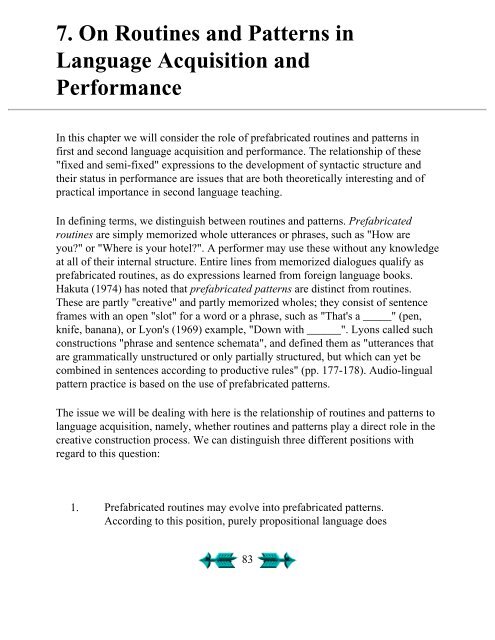Second Language Acquisition and Second ... - Stephen Krashen
Second Language Acquisition and Second ... - Stephen Krashen
Second Language Acquisition and Second ... - Stephen Krashen
Create successful ePaper yourself
Turn your PDF publications into a flip-book with our unique Google optimized e-Paper software.
7. On Routines <strong>and</strong> Patterns in<br />
<strong>Language</strong> <strong>Acquisition</strong> <strong>and</strong><br />
Performance<br />
In this chapter we will consider the role of prefabricated routines <strong>and</strong> patterns in<br />
first <strong>and</strong> second language acquisition <strong>and</strong> performance. The relationship of these<br />
"fixed <strong>and</strong> semi-fixed" expressions to the development of syntactic structure <strong>and</strong><br />
their status in performance are issues that are both theoretically interesting <strong>and</strong> of<br />
practical importance in second language teaching.<br />
In defining terms, we distinguish between routines <strong>and</strong> patterns. Prefabricated<br />
routines are simply memorized whole utterances or phrases, such as "How are<br />
you?" or "Where is your hotel?". A performer may use these without any knowledge<br />
at all of their internal structure. Entire lines from memorized dialogues qualify as<br />
prefabricated routines, as do expressions learned from foreign language books.<br />
Hakuta (1974) has noted that prefabricated patterns are distinct from routines.<br />
These are partly "creative" <strong>and</strong> partly memorized wholes; they consist of sentence<br />
frames with an open "slot" for a word or a phrase, such as "That's a _____" (pen,<br />
knife, banana), or Lyon's (1969) example, "Down with ______". Lyons called such<br />
constructions "phrase <strong>and</strong> sentence schemata", <strong>and</strong> defined them as "utterances that<br />
are grammatically unstructured or only partially structured, but which can yet be<br />
combined in sentences according to productive rules" (pp. 177-178). Audio-lingual<br />
pattern practice is based on the use of prefabricated patterns.<br />
The issue we will be dealing with here is the relationship of routines <strong>and</strong> patterns to<br />
language acquisition, namely, whether routines <strong>and</strong> patterns play a direct role in the<br />
creative construction process. We can distinguish three different positions with<br />
regard to this question:<br />
1. Prefabricated routines may evolve into prefabricated patterns.<br />
According to this position, purely propositional language does<br />
83











